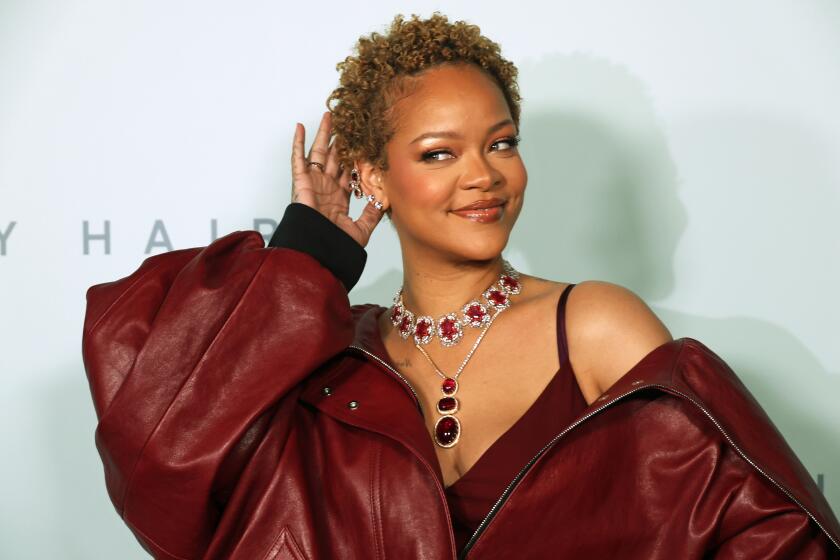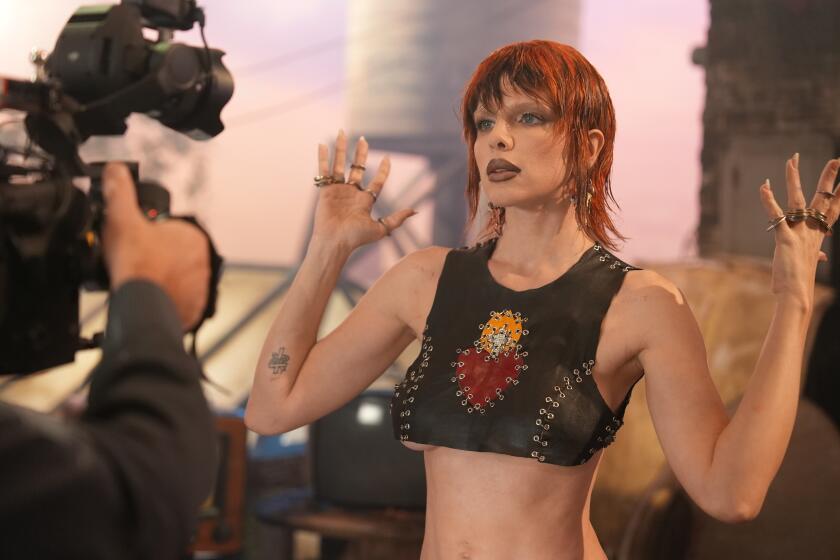‘Devil’ in a new dress
ANNA WINTOUR must be pleased. The new movie adaptation of “The Devil Wears Prada,” adapted from Lauren Weisberger’s barely skimmable roman a clef about the year she spent as the Vogue editor’s assistant, not only casts doubts as to who the actual heroine of the story is, it’s very clear on who’s the star of the show. A serious improvement on the tantrum that inspired it, the movie is funnier and more evenhanded in its point of view. If living well is the best revenge, then being portrayed by Meryl Streep in peak comic form has got to run a close second.
With her crested gray mane, laser glare and perfectly modulated stealth missile sarcasm, Miranda Priestly, the editor in chief of the fictional Vogue clone, Runway, is still a monster. But as the sage Bugs Bunny once noted, monsters are the most interesting people. Yes, she still makes constant, outrageous demands, but that’s just the surface, the icing, if you like. Streep invests her Miranda with the brains, ambition and cold blood to stay on top of what the saucer-eyed Andy Sachs (Anne Hathaway) sees as a frivolous fashion rag but others, including the world’s top designers and the head of the publishing company Elias-Clark, know to be a major cash cow, and therefore sacred.
Runway magazine sells desire, which in turn sells everything else. Desire is stoked by exclusivity and unattainability, so Miranda can hardly be cuddly or accessible. She enters each scene like a shark crashing a tuna party, dispersing smaller fish in all directions, and willfully refuses to learn Andy’s name until she’s good and ready.
Against such a formidable opponent, Andy doesn’t stand a chance. Nor should she. Hathaway plays a slightly different sort of Andy from the Andy of the book. Where she was a Connecticut-bred Brown University graduate, Andy is now slightly dowdier, more sincere, presumably with fewer semiotics classes under her belt.
Freshly sprung from Northwestern’s Medill School of Journalism, she nevertheless shows up for her interview at the fictional magazine publishing juggernaut Elias-Clark having never even heard the name Miranda Priestly. Considering Miranda’s celebrity editor status, and Andy’s credentials, this takes an added obtuseness. In the book, Andy’s not knowing who Miranda is was supposed to represent some kind of Ivy League purity. But the movie, thankfully, knows better.
Hathaway’s Andy is pretty and likable enough, but there’s something about her that gives off the unmistakable scent of a doofus. Hers is a bovine complacency that inspires aggression more than affection, and the hungry and panic-honed lackeys at Runway sense it right away.
No longer funneled through Andy’s blinkered point of view, and pretty well divested of its revenge agenda, the script generously distributes brains and a way with insults among the objects of Weisberger’s contempt. Miranda’s newly promoted first assistant, Emily (the scene-stealing Emily Blunt), despairs when Miranda unpredictably hires the hopelessly style-challenged and contemptuous Andy to take over her old job. Emily’s year-end perk of attending the Paris couture shows is contingent on Andy’s being able to keep it, and the precariousness of the situation turns her into a font of wry despair. (When Miranda’s driver text-messages Emily to inform her that Miranda will be arriving at the office earlier than expected because her facialist has ruptured a disc, a frazzled Emily moans, “God, these people!” )
Runway’s witty, soul-dead art director Nigel (Stanley Tucci) may be a sellout, but he’s still more nuanced and compelling than the New Yorker-fixated Andy, whose idealism betrays equal doses of snobbery, cluelessness and entitlement. Her boyfriend (wisely downgraded from saintly inner-city teacher to moral-relativist sous-chef, and played by the scruffy Adrian Grenier) is supportive of the gig, but even though he agrees with Andy that she’s destined for Greater Things, part of him wishes she would face up to her moral compromises and stop playing the victim.
Greater Things don’t often come with free $700 shoes, however, and Andy finds herself slowly sucked into the world of Runway. If Weisberger’s novel focuses obsessively on every sharp word and withering glance her evil dragon-lady boss ever threw her way, the movie lets us in on what keeps her there.
As tiresome as luxury-label name-dropping is in print, it’s another thing entirely on film. The idea that the Runway girls starve, suffer and otherwise mortify their flesh to “deserve” the clothes that flow from Runway’s fashion closet -- depicted here as a glowing temple to couture -- is a lot less mysterious after you get a glimpse of its contents.
But there’s more to it than that. Despite what she thinks, not even Andy is immune to Miranda’s punishing allure. As Nate points out after Andy breaks one too many dates, invoking the “I had no choice” defense for the umpteenth time, he reminds her that the person whose phone calls you always take is the person you’re in a relationship with. There’s a fine line between love and hate, and anyone but a fool could tell that Andy is starting to cross it.
Directed by David Frankel and written by Aline Brosh McKenna (with uncredited revisions by Don Roos and Paul Rudnick), “The Devil Wears Prada” spins Weisberger’s rant into a sharp, surprisingly funny excursion into the catty realm of women’s magazines. The movie skips the condescension usually aimed at this world in favor of rapt observation.
The result may be shallow, but it’s anything but cheap. From the opening montage, which juxtaposes the highly ritualized morning toilettes of Andy’s soon-to-be colleagues with her own careless ablutions, it’s clear that Andy is out of her league. The Runway girls -- or “clackers,” as Andy calls them, for the sound their stilettos make in the building’s lobby -- measure cereal and count their almonds while Andy inhales an abundantly schmeared onion bagel on her way to the office. It’s the sort of detail that could have functioned as proof of Andy’s sanity in an insane world, but if the movie knows one thing, it’s that one person’s normal is another’s pathetically out of touch.
The subculture at Runway may be venal and heartless, but it’s also consensual. (In a great bit of casting, the editorial lackeys at Runway are played by famous fashion models, including Gisele Bundchen as Miranda’s former first assistant, recently promoted.) And the fact that the movie understands the game makes everyone look a little better. The defining characteristic of Runway, after all, is not shallowness but cutthroat ambition and virulent aestheticism metastasized out of control. Miranda may be a harpy, but she’s also cunning, ruthless, disciplined and not always wrong.
Andy’s resistance eventually gives way as she succumbs to the many pleasures of life at Runway -- carte blanche to hate her boss being high among them. The movie’s smartest departure from the book is that the script grants Andy the chance to understand how complex her fixation is.
That she doesn’t ultimately choose to cleave herself to Miranda comes as no surprise -- in the mythology of the female coming-of-age story, virtue always wins out.
What is unexpected here is that the triumph of virtue -- with its attendant reversion to a Gap wardrobe -- doesn’t feel entirely triumphant. It smacks of giving up.
*
‘The Devil Wears Prada’
MPAA rating: PG-13 for some sensuality
A 20th Century Fox release of a Fox 2000 Pictures presentation. Director David Frankel. Screenplay Aline Brosh McKenna, based on the novel by Lauren Weisberger. Producer Wendy Finerman. Director of photography Florian Ballhaus. Editor Mark Livolsi. Running time 1 hour, 49 minutes.
In general release.



